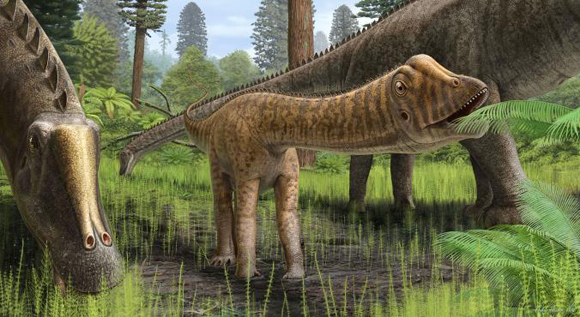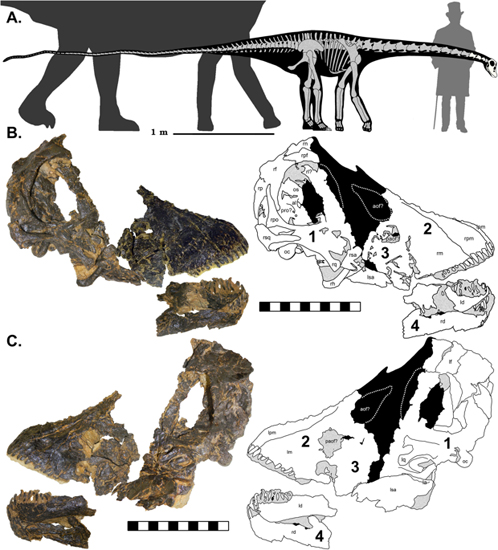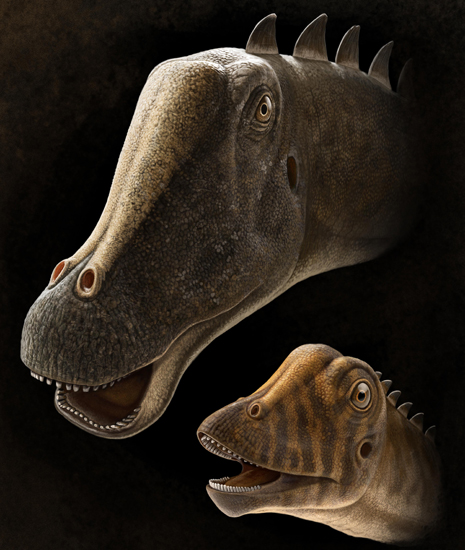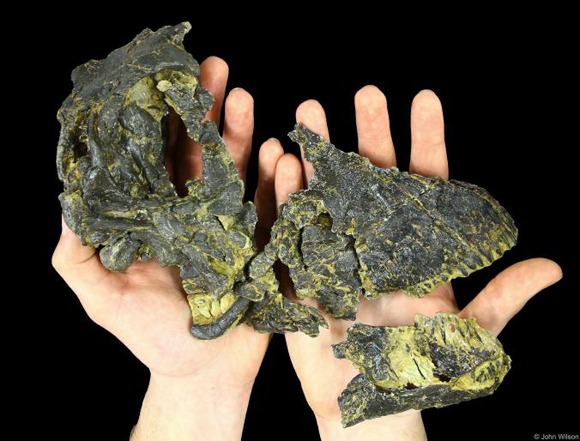Baby Diplodocid Skull Could Provide Fresh Insight into the Life of Diplodocus
A team of international researchers writing in the academic journal “Scientific Reports”, have described a partial skull of a diplodocid dinosaur. The skull, measuring just 24 centimetres long, is the smallest diplodocid skull described to date and it is helping to provide information on how long-necked dinosaurs such as Diplodocus changed as they grew.
Studying Diplodocus
The fossil (CMC VP14128), was collected back in 2010 from south, central Montana (Mother’s Day Quarry). The site contains the fossilised remains of at least sixteen immature diplodocids, that may have perished having been caught up in a turbulent mudflow. The skull, which consists of four large segments plus additional fragments, reveals that the heads of diplodocid dinosaurs changed as they got older and suggests that immature individuals fed on different types of vegetation (dietary partitioning relative to age). Groups of young animals may have stayed together in a creche, living apart from the adults, even occupying a different habitat.
The Fossilised Skull of a Young Diplodocid Hints at Dietary Partitioning

Picture credit: Andrey Atuchin
“Andrew” the Diplodocus
The specimen (CMC VP14128), also includes a rudimentary bone that links the skull to the cervical column (the proatlas) and four neck bones from the front part of the neck, closest to the skull. The fossil material has been assigned to the diplodocid species Diplodocus carnegii and the skull was nicknamed “Andrew” in honour of Andrew Carnegie, the Scottish-American industrialist and philanthropist, who did much to support the nascent science of palaeontology in the United States. The species D. carnegii is named after him in recognition of his financial support for expeditions to excavate fossils from the Morrison Formation.
The Immature Diplodocid Compared to an Adult and Andrew Carnegie (1.6 m tall) with Skull Views and Accompanying Line Drawings

Picture credit: Scientific Reports
The picture above shows a skeletal reconstruction of “Andrew” compared to Andrew Carnegie and an adult D. carnegii (A), the bones in the skeleton in white represent the fossil material (CMC VP14128). Right lateral view of the skull (B), with an accompanying line drawing and (C), a left lateral view of the skull with a line drawing. The four segments of the skull are numbered in the line drawings and the scale bar in (B) and (C) is ten centimetres.
Differences in the Shape of the Head of Young and Fully Grown Dinosaurs
Although the skull fossil has been crushed, the researchers, which included lead author Cary Woodruff (University of Toronto) and Glenn Storrs (Cincinnati Museum Centre), conclude that the juvenile, which was perhaps around 5 years of age and 5 metres long when it died, had a much narrower snout compared to the broad, wide snout of an adult. In addition, “Andrew” possessed thirteen teeth on each side of its lower jaw, some of which had spatulate, spoon-like edges to slice through tough vegetation. In contrast, fully-grown Diplodocus lower jaws had eleven teeth on each side and these were much more peg-like and were probably used to “comb” food in to the mouth.
This indicates that juveniles had different skull morphologies and dentition when compared to older, more mature animals and suggests resource partitioning between juveniles and adults. In short, juvenile Diplodocus probably fed on different plants compared to the grown-ups.
For models and replicas of Diplodocus and other dinosaurs: Rebor Dinosaur and Prehistoric Animal Models.
An Adult Diplodocus had a Differently Shaped Head and Snout Compared to a Juvenile

Picture credit: Andrey Atuchin
This research is consistent with the theory that immature diplodocids adopted a different feeding strategy, grazing on a greater variety of plants, whilst the adults were predominantly ground-level browsers.
To read an article from 2010 that hypothesised that baby dinosaurs had different skull morphologies and facial features when compared to adults: Juvenile Diplodocus Skull Study Suggests Baby Dinosaurs Had Different Shaped Skulls Compared to the Adults.
Commenting on the significance of this research, lead author Cary Woodruff, stated”
“Because they have [Diplodocus juveniles] got these different tooth types, it’s kind of like of a Swiss army knife in their mouth, right? They can pick and eat every plant they want to. They had free rein at the salad bar.”
Young Diplodocids Living in Woodland Habitats
The skull and tooth morphology of Diplodocus suggests that these animals transitioned through distinct feeding roles over their lifespan and vindicates the dramatised life story of a Diplodocus in the ground-breaking BBC television documentary series “Walking with Dinosaurs”. In episode two “Time of the Titans”, the story of a Diplodocus from hatching to reaching adulthood was told and juveniles were depicted as living in groups within the forests, only joining the adults on the open plains when they were much larger, too large for most predators to tackle.
The different skull shapes and dentition suggest that juvenile diplodocids lived in more forested environments than the adults that (restricted and protected by their size), were most likely browsing in more open habitats.
For an article published in 2012 on Diplodocus feeding strategies: Diplodocus Feeding Frenzy – A Biter or a Comber?
Lead Author of the Study Cary Woodruff Holds the Skull of a Juvenile Diplodocid
Picture credit: John P Wilson
The scientific paper: “The Smallest Diplodocid Skull Reveals Cranial Ontogeny and Growth-Related Dietary Changes in the Largest Dinosaurs” by D. Cary Woodruff, Thomas D. Carr, Glenn W. Storrs, Katja Waskow, John B. Scannella, Klara K. Nordén and John P. Wilson published in Scientific Reports.
Visit the Everything Dinosaur website: Everything Dinosaur.







Leave A Comment